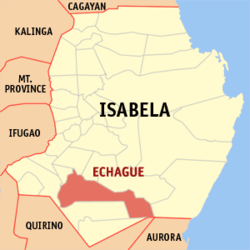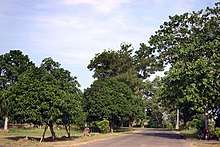Echague
Echague, officially the Municipality of Echague, is a 1st class municipality in the province of Isabela, Philippines. According to the 2015 census, it has a population of 79,094 people.[3] The town is known for the indigenous and endangered Yogad language, which is spoken and conserved by its locals.
Echague | |
|---|---|
| Municipality of Echague | |
 Seal | |
| Nickname(s): Queen Town of Isabela; Home of the Mengals | |
 Map of Isabela with Echague highlighted | |
OpenStreetMap 
| |
.svg.png) Echague Location within the Philippines | |
| Coordinates: 16°42′N 121°39′E | |
| Country | |
| Region | Cagayan Valley (Region II) |
| Province | Isabela |
| District | 6th District of Isabela |
| Barangays | 64 (see Barangays) |
| Government | |
| • Type | Sangguniang Bayan |
| • Mayor | Francis Faustino A. Dy |
| • Vice Mayor | Amador A. Gaffud, Jr. |
| • Congressman | Faustino Michael T. Dy III |
| • SP Board member | Noel Ildefonso |
| • Electorate | 54,715 voters (2019) |
| Area | |
| • Total | 680.80 km2 (262.86 sq mi) |
| Population (2015 census)[3] | |
| • Total | 79,094 |
| • Density | 120/km2 (300/sq mi) |
| • Households | 18,536 |
| Economy | |
| • Income class | 1st municipal income class |
| • Poverty incidence | 15.77% (2015)[4] |
| • Revenue (₱) | 240,331,816.37 (2016) |
| Time zone | UTC+8 (PST) |
| ZIP code | 3309 |
| PSGC | |
| IDD : area code | +63 (0)78 |
| Climate type | tropical rainforest climate |
| Native languages | Yogad Ilocano Tagalog |
| Website | www |
History
Prior to 1856, there were only two provinces in the Cagayan Valley Region: Cagayan and Nueva Vizcaya. The Province of Cagayan at that time consisted of all towns from Tumauini to the north in Aparri and all other towns from Ilagan City southward to Aritao comprised the Province of Nueva Vizcaya. In order to facilitate the work of the missionaries in the evangelization of the Cagayan Valley, a royal decree was issued on May 1, 1856 that created the Province of Isabela consisting of the towns of Gamu, Angadanan, Bindang (now Roxas) and Camarag (now Echague), Carig (now Santiago City) and Palanan. The new province was named in honor of Queen Isabela II of Spain.
Fr. Pedro Salgado, the Dominican writer, in volume I of his "Cagayan Valley and Eastern Cordillera (1581-1898)," wrote that Echague town in Isabela used to be called Camarag, the name of a big tree then common in the place.
The town was founded in 1752 and ecclesiastically placed under the patronage of St. Joseph on May 12, 1753.
History says missionaries wanted to transfer the town from the banks of the Cagayan River to the Ganano River 10 kilometers away. The people rebelled because the soil was more fertile along the Cagayan River. But in 1776, they were forcibly transferred.
Some 72 years later, the people returned to Camarag, now named Echague after Rafael de Echagüe y Bermingham, Spanish governor-general at that time.
Barangays
Echague is politically subdivided into 64 barangays. [2]
- Angoluan
- Annafunan
- Arabiat
- Aromin
- Babaran
- Bacradal
- Benguet
- Buneg
- Busilelao
- Cabugao (Poblacion)
- Caniguing
- Carulay
- Castillo
- Dammang East
- Dammang West
- Diasan
- Dicaraoyan
- Dugayong
- Fugu
- Garit Norte
- Garit Sur
- Gucab
- Gumbauan
- Ipil
- Libertad
- Mabbayad
- Mabuhay
- Madadamian
- Magleticia
- Malibago
- Maligaya
- Malitao
- Narra
- Nilumisu
- Pag-asa
- Pangal Norte
- Pangal Sur
- Rumang-ay
- Salay
- Salvacion
- San Antonio Ugad
- San Antonio Minit
- San Carlos
- San Fabian
- San Felipe
- San Juan
- San Manuel (formerly Atelan)[5]
- San Miguel
- San Salvador
- Santa Ana
- Santa Cruz
- Santa Maria
- Santa Monica
- Santo Domingo
- Silauan Sur (Poblacion)
- Silauan Norte (Poblacion)
- Sinabbaran
- Soyung (Poblacion)
- Taggappan (Poblacion)
- Tuguegarao
- Villa Campo
- Villa Fermin
- Villa Rey
- Villa Victoria
Demographics
|
| |||||||||||||||||||||||||||||||||||||||||||||
| Source: Philippine Statistics Authority[3][6][7][8] | ||||||||||||||||||||||||||||||||||||||||||||||
In the 2015 census, the population of Echague, Isabela, was 79,094 people,[3] with a density of 120 inhabitants per square kilometre or 310 inhabitants per square mile.
Climate
| Climate data for Echague, Isabela | |||||||||||||
|---|---|---|---|---|---|---|---|---|---|---|---|---|---|
| Month | Jan | Feb | Mar | Apr | May | Jun | Jul | Aug | Sep | Oct | Nov | Dec | Year |
| Average high °C (°F) | 29 (84) |
30 (86) |
32 (90) |
35 (95) |
35 (95) |
35 (95) |
34 (93) |
33 (91) |
32 (90) |
31 (88) |
30 (86) |
28 (82) |
32 (90) |
| Average low °C (°F) | 19 (66) |
20 (68) |
21 (70) |
23 (73) |
23 (73) |
24 (75) |
23 (73) |
23 (73) |
23 (73) |
22 (72) |
21 (70) |
20 (68) |
22 (71) |
| Average precipitation mm (inches) | 31.2 (1.23) |
23 (0.9) |
27.7 (1.09) |
28.1 (1.11) |
113.5 (4.47) |
141.4 (5.57) |
176.4 (6.94) |
236.6 (9.31) |
224.9 (8.85) |
247.7 (9.75) |
222.9 (8.78) |
178 (7.0) |
1,651.4 (65) |
| Average rainy days | 10 | 6 | 5 | 5 | 13 | 12 | 15 | 15 | 15 | 17 | 16 | 15 | 144 |
| Source: World Weather Online[9] | |||||||||||||
Local government
style="text-align:center;" | Juan
| Position | Name |
|---|---|
| District Representative (6th Legislative District of the Province of Isabela) | Faustino A. Dy V |
| Chief Executive of the Municipality of Echague | Mayor Francis Faustino A. Dy |
| Presiding Officer of the Municipal Council of Echague | Vice Mayor Amador A. Gaffud, Jr. |
| Councilors of the Municipality of Echague | Judith Ildefonso |
| Allan P. Tupong | |
| Marcos D. Baccay, Jr. | |
| Marlon B. Lim | |
| Marcelina M. Alzate | |
| Nolito D. Panganiban | |
| Walter C. Uy | |
| Roher A. Ballad | |
Education

Universities:
- Isabela State University (Main Campus)
Main secondary schools:
- School of St. Joseph the Worker
- Ugad High School
- ISU Laboratory High School
- Saint Dominic Human Development Center (SDHDC)
- Echague National High School
- Don Mariano Marcos National High School
- Imelda R. Marcos High School - Main
- Imelda R. Marcos High School - Annex
- Doña Magdalena H. Gaffud High School
- Highway Region National High School
- Pangal Sur High School
Main elementary schools:
- Echague East Central School
- Echague West Central School
- Echague South Central School
- First Echague United Methodist School
- St. Dominic Human Development Center
- School of Saint Joseph the Worker
- First Echague United Methodist School
- InterActive Children Learning School (Pre-School and Grade School)
- St. Joseph Vineyard Montessori School
- Precious Gift Learning School, Inc.
- Annafunan Elementary School
- Buneg Elementary School
- Santo Domingo Elementary School
- Carulay Elementary School
- Dugayong Elementary School
- Salay Elementary School
- Soyung Elementary School
Forest Region elementary schools:
- Narra Elementary School
- Aromin Elementary School
- Salvacion Elementary School
- Pag-asa Elementary School
- Villa Rey Elementary School
- Villa Campo Elementary School
- Diasan Elementary School
- Mabbayad Elementary School
- Madadamian Elementary School
- Benguet Elementary School
- San Miguel Elementary School
- Dicaraoyan Elementary School
- Dammang Malitao Elementary School
- Dammang East Elementary School
- Malitao Elementary School
- Busilelao Elementary School
- Rumang-ay Elementary School
- Bacradal Elementary School
- San Salvador Elementary School
References
- "Municipality". Quezon City, Philippines: Department of the Interior and Local Government. Retrieved 31 May 2013.
- "Province: Isabela". PSGC Interactive. Quezon City, Philippines: Philippine Statistics Authority. Retrieved 12 November 2016.
- Census of Population (2015). "Region II (Cagayan Valley)". Total Population by Province, City, Municipality and Barangay. PSA. Retrieved 20 June 2016.
- "PSA releases the 2015 Municipal and City Level Poverty Estimates". Quezon City, Philippines. Retrieved 1 January 2020.
- "An Act Changing the Name of Barrio Atelan, in the Municipality of Echague, Province of Isabela, to San Miguel". LawPH.com. Archived from the original on 2012-07-13. Retrieved 2011-04-11.
- Census of Population and Housing (2010). "Region II (Cagayan Valley)". Total Population by Province, City, Municipality and Barangay. NSO. Retrieved 29 June 2016.
- Censuses of Population (1903–2007). "Region II (Cagayan Valley)". Table 1. Population Enumerated in Various Censuses by Province/Highly Urbanized City: 1903 to 2007. NSO.
- "Province of Isabela". Municipality Population Data. Local Water Utilities Administration Research Division. Retrieved 17 December 2016.
- "Echague, Isabela: Average Temperatures and Rainfall". World Weather Online. Retrieved 31 October 2015.
- "2019 Election Results:Echague, Isabela". GMA News. Retrieved 22 May 2019.